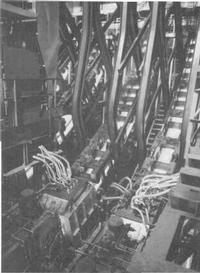


Chapter 12
I The First Half Century - The Initial Struggle
II The Second Fifty Years - The Start Of Expansion
III The Third Fifty Years - Federation And The First World War
IV The Fourth Period - Second World War To The Present
i General Conditions
ii Iron and Steel Production
iii Aluminium Technology
iv Innovative Copper Refining Process
v The EDIM-4WD Load-Haul-Dump Vehicle
vi Copper Rod Production
vii Copper Wire and Cables
viii The Diecasting Industry
ix Automotive Components
x Whitegoods or Consumer Durables
xi Hardware
xii Some Recent New Industries
xiii The National Measurement System
xiv Manufacturing Industry in this Decade
xv Acknowledgements
References
Index
Search
Help
Contact us

A requirement arose for bullet proof plate for armoured vehicles and the associated problems were tackled by BHP and Lysaght. Because of shortages of the typical alloying elements used in these steels, BHP had to devise alternative compositions, steels that were finally rolled and heat treated by Lysaght or BHP depending on thickness. After intensive development involving composition, rolling conditions and heat treatments, a satisfactory ABP3 (bullet proof plate) was produced in thicknesses 4.2 to 31.75 mm. This product was also satisfactorily weldable and machinable and represented a major development by the two companies.
In addition to ABP3, a special 500 tonnes of a new non-magnetic armour was rolled for the Navy using steel supplied by Commonwealth Steel Company. A further special quality steel of high carbon content was produced during this period and used to make bush knives, machetes etc., which were required by the Army in hundreds of thousands. At peak production some fourteen thousand knives a week were being finished and packed.
During 1940, Australia was informed that Britain could no longer supply magnesium which was essential for many wartime purposes including aircraft construction. BHP in Newcastle accepted the challenge, sent two technical staff to Britain to study production methods and, on their return, constructed a magnesium producing plant at Newcastle within one year. The plant contained a number of ingenious innovations, some required because of wartime shortage of essential equipment. The plant capacity was sufficient for Australian war needs but it was finally closed down some years after the end of the war.
A further triumph for the BHP Newcastle plant at this time was the introduction of the manufacture of tungsten carbide, the very hard compound needed for such things as the dies for wire drawing and for the manufacture of 25 pounder high explosive shells that were being made by BHP. The techniques and processing had to be researched and developed by BHP staff from the inadequate details then available in the literature, but by the end of 1941, a satisfactory product was being produced on a regular basis. A third important development at Newcastle was the production of ferro-alloys.
While both Newcastle and Port Kembla steel plants took up their wartime roles from a well founded base of iron and steel production, the plant at Whyalla had to be largely built up during the war period. One of the main requirements of the town and works was an adequate water supply, which was not assured until the water pipeline from the Murray River to Whyalla, a distance of 350 km, was completed in March 1943. A major purpose of the Whyalla works was shipbuilding and by the end of the war ten ships had been built, four corvettes for the Royal Australian Navy, four 'River' class cargo vessels and two Chieftain class ore carriers which replaced the two torpedoed BHP ships. The major construction at Whyalla was the blast furnace modelled on the No. 3 furnace at Newcastle and which was finished by mid 1941. Recently at BHP Rod and Bar Division, Newcastle, a modernization programme has included the latest continuous billet caster, (see Fig 4).

Organisations in Australian Science at Work - B.H.P. Steel International. Rod and Bar Division; Lysaght's Works Pty Ltd
 |
Australian Academy of Technological Sciences and Engineering |  |
© 1988 Print Edition page 882, Online Edition 2000
Published by Australian Science and Technology Heritage Centre, using the Web Academic Resource Publisher
http://www.austehc.unimelb.edu.au/tia/861.html